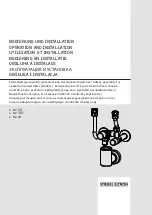
INSTALLATION INSTRUCTIONS
TR05A153.B1107
25
4.8 Flue connections
In order to ensure that the appliance functions correctly
and
efficiently,
only
Warmflow-approved
flue
components may be used with this appliance.
Traditional flue components cannot be used for
conveying exhaust fumes from condensing boilers.
Coaxial Balanced Flues
Where a horizontal balanced flue system is installed, the flue
must be positioned level, not sloping upwards or downwards.
The exhaust duct and air intake ducts have been designed so as
to minimise the build-up of condensate in the flue and protect
against the effect of the weather or the ingress of foreign bodies.
Twin Pipe Flues
For the exhaust discharge duct of a twin pipe system, the entire
length of the duct must slope
upwards towards the exterior
in
order to facilitate the flow of condensate back to the combustion
chamber, which has been specifically designed to collect and
drain the acidic condensate;
For the air intake duct of a twin pipe system, the entire length of
the duct must slope
downwards towards the exterior
to prevent
the entry of rainwater, dust or foreign bodies.
Reference Information – Type C Appliances
Exhaust flues for gas-fired appliances are classified at European level according to the method used for drawing
combustion air to and discharging exhaust fumes from the appliance. This classification applies to gas-fired
appliances in general.
The combustion circuit (air intake, combustion chamber, heat exchanger and fumes exhaust discharge) of Type C
Appliances is sealed off from the room in which the appliance is installed, i.e. room sealed. The combustion air
intake and the fumes exhaust discharge are connected directly to the outside.
4
0
O
N
5 0
0
.5
6
0
7
0
8
0
8
0
7
0
6
0
0
.5
5
0
O
N
4
0
C43
C83
C53
8
0
7
0
6
0
0
.5
5
0
O
N
4
0
C13
4
0
O
N
5
0
0
.5
6
0
7
0
8
0
4
0
O
N
5
0
0
.5
6
0
7
0
8
0
C33
Figure 16: Appliance and flue types
C32
C12
C52
C82
C42
















































